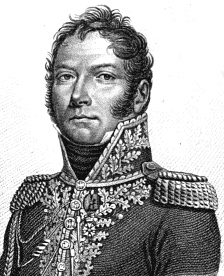General Paul Jean Baptiste Poret de Morvan

Born: April 14, 1777
Place of Birth: Saint-Etienne-sous-Bailleul, Eure, France
Died: February 17, 1834
Place of Death: Chartres, France
Arc de Triomphe: PORET DE MORVAN on the north pillar
Joining the artillery during the Revolution in 1793, Paul Jean Baptiste Poret de Morvan served against Spain for the beginning of his career. He later served in the chasseurs à cheval of the Vendée and in 1799 he joined the auxiliary battalion of Rhône. In 1800 Poret de Morvan served with the Army of Italy and he was wounded at the affair of Sassello in April. That September he was promoted to sous-lieutenant and then in 1801 he joined the 90th of the Line.
In 1802 Poret de Morvan was designated for the expedition to Saint-Domingue where he would serve in the guard of the the commander-in-chief General Leclerc. After receiving a promotion to lieutenant in September, he was wounded by a ball to the body in the assault of Fort Saint-Michel in October. After General Leclerc's death, Poret de Morvan accompanied Leclerc's body back to France and he was then named a lieutenant in the Grenadiers à Pied of the Guard.
During the War of the Third Coalition and the War of the Fourth Coalition, Poret de Morvan served in Austria, Prussia, and Poland. In May of 1806 he was promoted to capitaine. In 1808 he served in the 2nd Battalion of the 2nd Regiment of the Grenadiers of the Guard and in 1809 he served during the Danube campaign against Austria. That June he was promoted to chef de bataillon and given command of the 1st Battalion of the 1st Tirailleurs-Grenadiers of the Guard and then in July he served at the Battle of Wagram .
In 1810 Poret de Morvan served in the Army of the North in Spain under General Dorsenne. In 1811 he took part in deterring enemy forces from Ciudad-Rodrigo and at the end of the year he was promoted to colonel of the 34th Light. Poret de Morvan was named a Knight of the Empire in February of 1812 and in May he took command of the city and province of Soria. He defended the city against Spanish guerillas but he was wounded twice and at the end of August he returned to France to recover. In January of 1813 Poret de Morvan was named colonel-major of the 3rd Tirailleurs-Grenadiers of the Imperial Guard and he served in Saxony during the campaign that year, serving in the Young Guard in Barrois' division. He fought at the Battle of Bautzen where he took a redoubt and later he was named a Commander of the Legion of Honor. In August Poret de Morvan was named a Baron of the Empire and he stepped up to command a brigade of Barrois' division of the Young Guard at the Battle of Dresden. A few days later his position was confirmed and he was promoted to général de brigade. That October Poret de Morvan fought at the Battle of Leipzig and during the retreat afterwards he fought at the combat of Eisenach where he was wounded in the foot.
For the defense of France of 1814, Poret de Morvan was ordered to form a division for the Young Guard in January. In February he took command of the 3rd Division of the Young Guard and then he took command of a brigade of that division that was sent from Paris to Champagne. Poret de Morvan served under Marshal Mortier in March and he fought at Craonne and then he was wounded at Laon by grapeshot. Afterwards his division was dissolved and he took command of the 2nd Brigade of Grenadiers of the Old Guard. At the end of March, Poret de Morvan served at the defense of Paris.
After Napoleon's abdication and the Bourbon Restoration, Poret de Morvan was placed with the chasseurs à pied of France. When Napoleon returned to power in 1815 for the Hundred Days, Poret de Morvan was named colonel of the 3rd Grenadiers à Pied of the Old Guard. Poret de Morvan served as part of Roguet's division during the campaign in Belgium in June, and he fought at both the Battle of Ligny and the Battle of Waterloo. After the French retreat, he served in the Army of the Loire but was then arrested and imprisoned at Paris in January of 1816. However, when Poret de Morvan was transferred to Strasbourg, he escaped with help from his wife.1 He was amnestied in 1817 and he returned to France.
Notes
Bibliography
- Divry, Arnauld. Les Noms Gravés sur l'Arc de Triomphe. Paris: L'Harmattan, 2017.
- Six, Georges. Dictionnaire Biographique des Généraux & Amiraux Français de la Révolution et de l'Empire (1792-1814). 2 vols. Paris: Gaston Saffroy, 2003.
External Links:
Updated May 2019
© Nathan D. Jensen